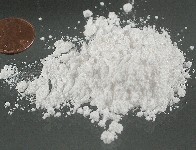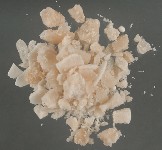  Cocaine (upper left) is an alkaloid found in the leaves of the South American shrub Erythroxylon coca. It's most common pure form is as a white powder, a hydrochloride salt. Cocaine is a psychostimulant ... the drug induces a sense of exhilaration and strong feelings of self-confidence, conversational prowess and intensified consciousness. Cocaine can enter the body through blood capillaries, so it is often taken through the nose. It can also be dissolved in water and injected. In smokeable form, it is called crack (see a large photo), which is produced by heating cocaine in a solution of baking soda until the water evaporates. This form of the drug vaporizes easily when heated, so it can be smoked; it makes a cracking sound when heated, hence the name 'crack'. The faster the absorption by the body, the more intense the pleasureable feelings will be. However, the faster the absorption, the shorter the duration of the 'high'. The high from taking cocaine through the nose may last 15-30 minutes, while that from smoking may last only 5-10 minutes. Increased use of cocaine reduces the period of time a user feels high. Cocaine is a strong central nervous system stimulant that interferes with the absorption of dopamine, a chemical associated with the so-called pleasure centre of the brain. A buildup of dopamine due to cocaine use causes continuous stimulation of the receiving neurons in the brain, which results in the feeling of euphoria experienced by cocaine users. While the euphoria produced by cocaine and crack is intense, the down side once the drug has worn off is truly horrible. It involves anxiety, depression, irritability, extreme fatigue and paranoia. Physical health deteriorates. If cocaine is taken through the nose, a chronically runny nose develops, along with frequent nosebleeds, and the entire lining in the nasal cavity eventually disintegrates. An intense craving for more cocaine develops, but at the same time the brain's capacity to experience pleasure is diminished, so more and more of the drug needs to be consumed. A compulsion to use the drug overwhelms any social or ethical considerations; addicted users will alienate family and friends, selling posessions, stealing and committing crimes of violence in order to make money to pay for the drug. Most of their time while not using the drug is spent thinking about how to get more of the drug. Other problems associated with cocaine use include changes in heart rhythm, heart attacks, respiratory failure, strokes, seizures, and abdominal pain and nausea. Because cocaine may result in a decrease in appetite, many habitual users become malnourished. |